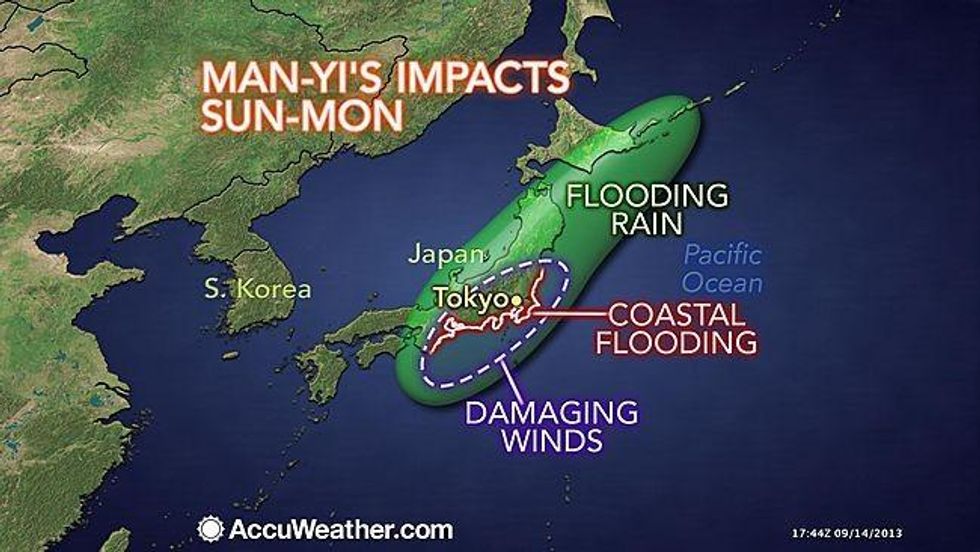

SUBSCRIBE TO OUR FREE NEWSLETTER
Daily news & progressive opinion—funded by the people, not the corporations—delivered straight to your inbox.
5
#000000
#FFFFFF
To donate by check, phone, or other method, see our More Ways to Give page.


Daily news & progressive opinion—funded by the people, not the corporations—delivered straight to your inbox.

Ahead of the storm's landfall, fears were that high winds and rising waters could further destabilize the crippled Fukushima Daiichi plant, which sits on the coast northeast of Tokyo.
Though the storm battered southern prefectures of the island nation, sparking flash floods and mudslides in Saitama, Fukui, and Kyoto--Fukushima did not take a direct hit as was feared over the weekend.
However, as heavy rains continued throughout the day, the water storage areas that blanket the area around the Fukushima plant came under threat.
And as Channel NewsAsia reports:
[TEPCO]workers were pumping out water from areas near tanks storing radioactive water, from which leaks are believed to have seeped into groundwater.
"But we decided to release the water into sea as we reached a conclusion that it can be regarded as rainfall after we monitored levels of radiation," TEPCO spokesman Yo Koshimizu said.
According to the spokesman, one litre of the water contained up to 24 becquerels of strontium and other radioactive materials -- below the 30 becquerel per litre safety limit imposed by Japanese authorities for a possible release to the environment.
However, it was unknown how much water was released to sea under the "emergency measure," Koshimizu said.
_______________________________________________
Dear Common Dreams reader, The U.S. is on a fast track to authoritarianism like nothing I've ever seen. Meanwhile, corporate news outlets are utterly capitulating to Trump, twisting their coverage to avoid drawing his ire while lining up to stuff cash in his pockets. That's why I believe that Common Dreams is doing the best and most consequential reporting that we've ever done. Our small but mighty team is a progressive reporting powerhouse, covering the news every day that the corporate media never will. Our mission has always been simple: To inform. To inspire. And to ignite change for the common good. Now here's the key piece that I want all our readers to understand: None of this would be possible without your financial support. That's not just some fundraising cliche. It's the absolute and literal truth. We don't accept corporate advertising and never will. We don't have a paywall because we don't think people should be blocked from critical news based on their ability to pay. Everything we do is funded by the donations of readers like you. Will you donate now to help power the nonprofit, independent reporting of Common Dreams? Thank you for being a vital member of our community. Together, we can keep independent journalism alive when it’s needed most. - Craig Brown, Co-founder |

Ahead of the storm's landfall, fears were that high winds and rising waters could further destabilize the crippled Fukushima Daiichi plant, which sits on the coast northeast of Tokyo.
Though the storm battered southern prefectures of the island nation, sparking flash floods and mudslides in Saitama, Fukui, and Kyoto--Fukushima did not take a direct hit as was feared over the weekend.
However, as heavy rains continued throughout the day, the water storage areas that blanket the area around the Fukushima plant came under threat.
And as Channel NewsAsia reports:
[TEPCO]workers were pumping out water from areas near tanks storing radioactive water, from which leaks are believed to have seeped into groundwater.
"But we decided to release the water into sea as we reached a conclusion that it can be regarded as rainfall after we monitored levels of radiation," TEPCO spokesman Yo Koshimizu said.
According to the spokesman, one litre of the water contained up to 24 becquerels of strontium and other radioactive materials -- below the 30 becquerel per litre safety limit imposed by Japanese authorities for a possible release to the environment.
However, it was unknown how much water was released to sea under the "emergency measure," Koshimizu said.
_______________________________________________

Ahead of the storm's landfall, fears were that high winds and rising waters could further destabilize the crippled Fukushima Daiichi plant, which sits on the coast northeast of Tokyo.
Though the storm battered southern prefectures of the island nation, sparking flash floods and mudslides in Saitama, Fukui, and Kyoto--Fukushima did not take a direct hit as was feared over the weekend.
However, as heavy rains continued throughout the day, the water storage areas that blanket the area around the Fukushima plant came under threat.
And as Channel NewsAsia reports:
[TEPCO]workers were pumping out water from areas near tanks storing radioactive water, from which leaks are believed to have seeped into groundwater.
"But we decided to release the water into sea as we reached a conclusion that it can be regarded as rainfall after we monitored levels of radiation," TEPCO spokesman Yo Koshimizu said.
According to the spokesman, one litre of the water contained up to 24 becquerels of strontium and other radioactive materials -- below the 30 becquerel per litre safety limit imposed by Japanese authorities for a possible release to the environment.
However, it was unknown how much water was released to sea under the "emergency measure," Koshimizu said.
_______________________________________________